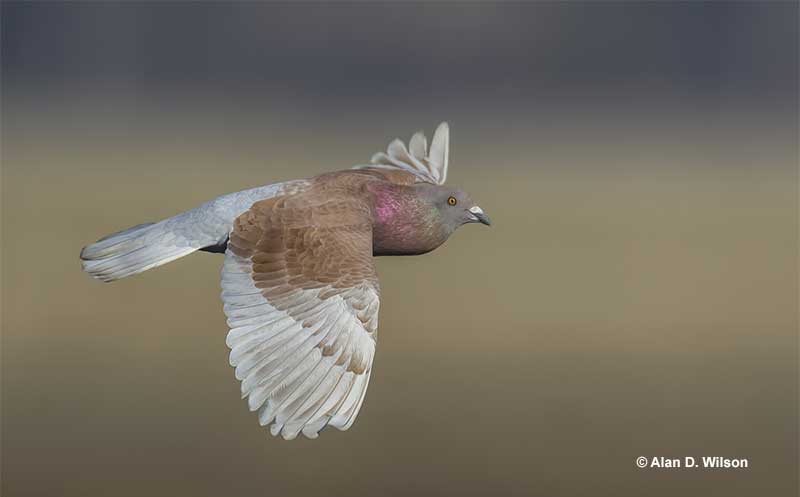Rock Pigeons (Columba livia), also known as Rock Doves or just simply pigeons, have established a strong and unique connection with humans, particularly in urban environments.
Adaptability is a hallmark of their behavior, allowing them to thrive in diverse landscapes across the globe.
Ever wondered if there’s anything more to those birds we commonly see in our everyday lives? Let’s find out!
On this page
Rock Pigeon Identification
Rock Pigeons measure 11-15 inches long with a wingspan of 24-28 inches. They have a stout and compact body with a relatively short neck and a small, rounded head with a small, dark beak. Their tails are wide and rounded when fanned out and their wings are pointed and broad.

Male and female Rock Pigeons are identical. The adult of the nominate subspecies has a lightish gray body with two dark bands across their wings and a dark band at the tip of their tails.
Their heads are slightly darker bluish-gray and their necks are covered with green and purple iridescence. Juvenile Rock Pigeons are duller and have less iridescence but have the same appearance overall.
However, their plumage can vary quite a bit. The variations can be as small as the bird being slightly darker or having more markings to being a different color.
Birds in urban areas often develop darker plumage than those in rural areas. There are also individuals whose plumage is a mix of rusty colors and white. Some can be entirely white.
Vocalizations
The most iconic sound associated with pigeons is the gentle and rhythmic cooing. This is often heard during courtship displays and is a way for pigeons to communicate with each other.
It is often described as a soft and repetitive coo, roo-c’too-coo. They also give hoot-like calls and short grunts. When they take flight, their wings make distinct sharp slapping sounds.
Rock Pigeon’s Diet
Rock Pigeons are highly adaptable birds when it comes to their diet. Their ability to thrive in urban environments is partly due to their opportunistic feeding behavior.
They have a strong preference for seeds and grains, including those from grasses, weeds, corn, oats, and others.
In urban settings, pigeons often forage for spilled or scattered birdseed, which can be found in parks, gardens, and around bird feeders.
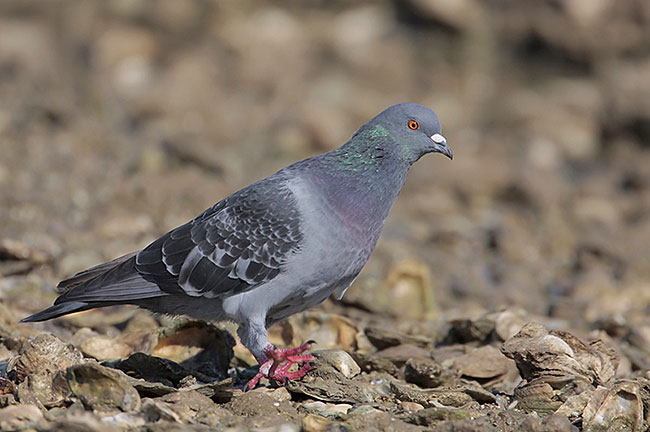
While seeds and grains are staples, pigeons also consume berries and fruits when available, including cherries and currants. Berries are picked from shrubs and trees or the ground. They supplement their diet with insects and invertebrates.
This includes small insects, worms, and other invertebrates that they may find while foraging on the ground. They also scavenge human food scraps and can become quite a nuisance in cities.
At times, you may see them peck at the ground when there’s seemingly nothing there. However, they do this to pick up small stones, also known as grit. This ingested grit helps in the digestion of tough seeds in their diet. The birds also drink water, but unlike most, they are able to drink continuously without having to tilt their heads back.
Nesting and Eggs
Rock Pigeons often mate for life and can breed at any time throughout the year. Courtship includes males puffing up their neck feathers and fanning their tails to appear large. They then approach the female, rapidly circle her, bow, and turn while cooing continuously.
Rock Pigeons nest on ledges and nooks of cliffs or manmade structures. Males choose the nest site, but both the male and female contribute to nest building.
They collect twigs, leaves, and other materials to construct a loose and relatively simple nest. The male Rock Pigeon presents nesting material to the female, and she arranges it in the chosen nesting site. They may use the same nest more than once.
Rock Pigeons can raise anywhere from one to six broods in a year with 1-3, mostly 2 white eggs in a clutch. Both parents take turns incubating the eggs, which takes 16-19 days and then take care of the chicks together. They produce something called crop milk and regurgitate it into the mouths of their offspring.
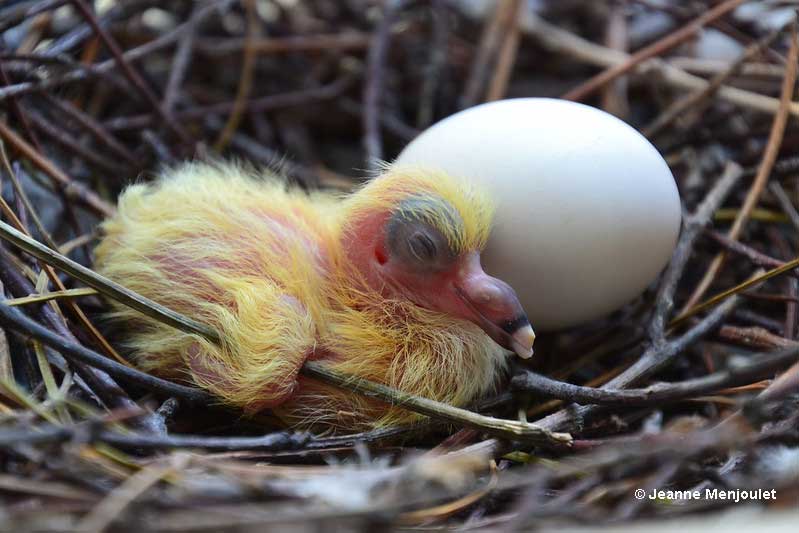
© Jeanne Menjoulet
The chicks fledge and leave the nest around 25 to 32 days after hatching. Even after fledging, the parents continue to care for and feed the young pigeons for a period before they become independent.
Current Situation
Rock Pigeons have a wide global distribution and are found on every continent except Antarctica. In North America, they are resident throughout their range and are only not found in the northernmost part of the continent.
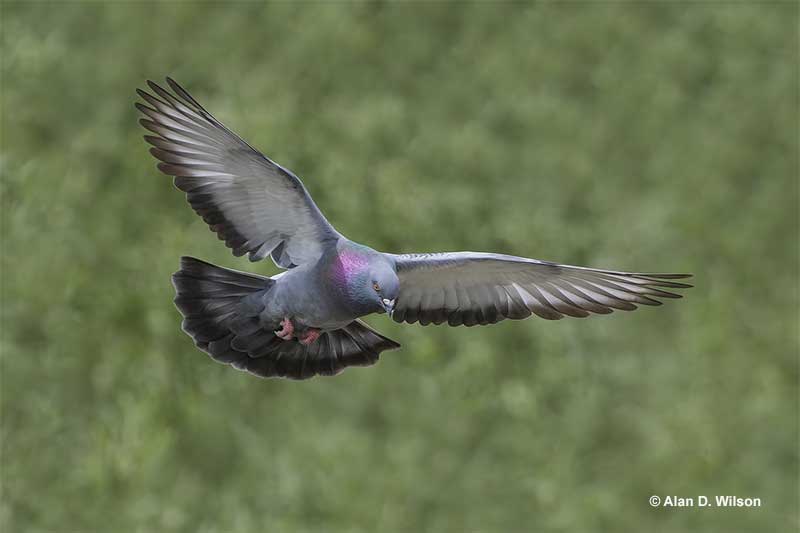
Rock pigeons are particularly abundant in urban and suburban areas. They are commonly seen in cities, towns, and villages around the world.
While they are strongly associated with urban settings, they can also be found in rural and agricultural areas. In coastal regions, rock pigeons can be found near cliffs, rocks, and sandy shores. They may use these areas for roosting and nesting.
Rock Pigeons are listed as a species of least concern on the IUCN Red List. Even though it may not seem like it, their population is decreasing, but their adaptability and ability to thrive near and with humans and within urban environments is a big plus.
Rock Pigeon Facts
- Rock Pigeons are also known as Rock Doves, Common Pigeons, or just pigeons. This is the species most of us think of when someone says pigeons.
- Rock Pigeons were domesticated more than 5,000 years ago. They were used to relay messages or bred to look beautiful or to be eaten. Nowadays, wild and feral populations have mixed so thoroughly that it is difficult to estimate their status.
- Pigeons navigate using the Earth’s magnetic fields and cues based on the sun’s position.
- In the wild, pigeons live for only 6 years or even less. However, one domesticated pigeon lived to be 31 years old.
Similar Species
Rock Pigeons are similar to many other pigeon species. Things become especially confusing when the Rock Pigeon doesn’t have the standard plumage. Here are some of the most similar species and easy ways to tell them apart.
Band-tailed Pigeon
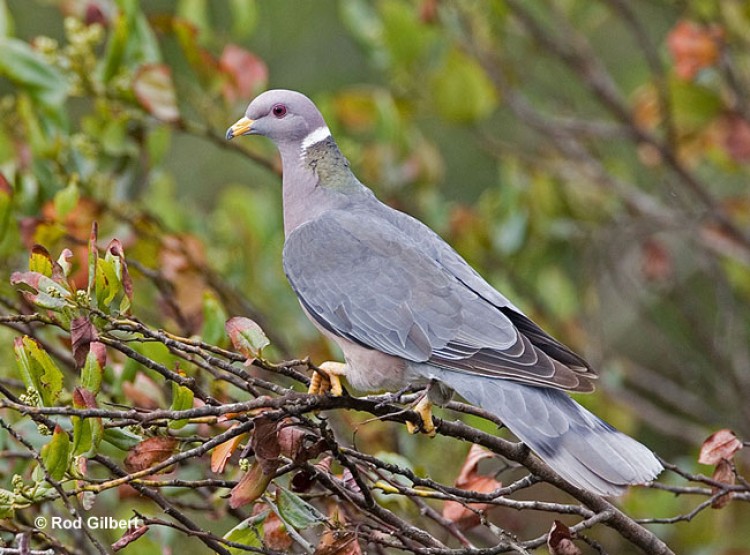
Band-tailed Pigeons range throughout western and southwestern North America. They have grayish upperparts, grayish-purple underparts, a white crescent at the back of their necks with green iridescence below it, and a pale tail tip. Their bills are yellow with a black tip.
You’re more likely to encounter Band-tailed Pigeons in rural areas than in urban environments. Compared to the nominal Rock Pigeon, Band-tailed Pigeons are more uniformly colored and their plumage is purplish instead of grayish and bluish. They also have a white crescent at the back of the neck and a pale tail tip but lack the two dark bands on their wings.
Mourning Dove
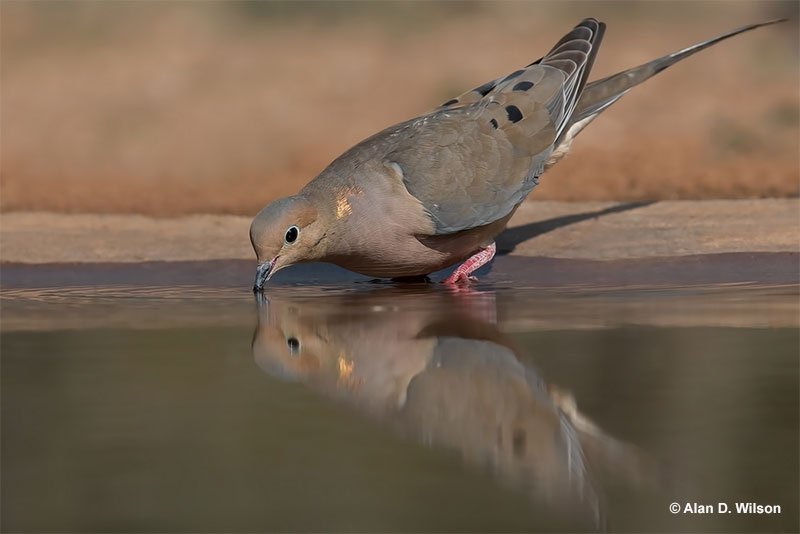
Mourning Doves range throughout most of North and Central America. They are pale grayish above and pale peach-colored below with black spots on the wings. In flight, you can see their distinct long fan-shaped tail.
This species is smaller than Rock Pigeons. Their tails are longer and they are pale tan overall instead of gray. In flight, Rock Pigeons have broad and rounded tails whereas Mourning Doves have distinctly longer and diamond-shaped tails.
Eurasian Collared-Dove

In North America, Eurasian Collared-Doves range throughout most of the United States. Adults are sand-colored overall and slightly paler on the underside. They have distinct black crescents on the back of their necks, hence the name. In flight, look for black wingtips and white outer tail feathers.
You might mistake Eurasian Collared-doves for rust-colored Rock Pigeons. However, the Collared-doves are often more uniformly colored and have that black collar that Rock Pigeons lack.
Learn more: Dove species in the U.S.
Frequently Asked Questions
How many Rock Pigeons are there?
It is estimated that there are up to 120 million Rock Pigeons worldwide.
How are Rock Pigeons so widespread?
Rock Pigeons are so widespread due to their highly adaptable nature and the fact that they were domesticated long ago and the escaped birds have contributed to wild populations.
Are Rock Pigeons invasive?
Depending on the location, Rock Pigeons may be considered invasive.
What is another name for a Rock Pigeon?
Rock Pigeons are also called Rock Doves or Common Pigeons.
How long do Rock Pigeons live?
Rock Pigeons live for 3-6 years in the wild on average.
Are albino Rock Pigeons common?
Albino Rock Pigeons make up only around 1% of the pigeon population, which makes them very rare.

